Simon Benninga. Financial Modelling 3-rd edition
Подождите немного. Документ загружается.

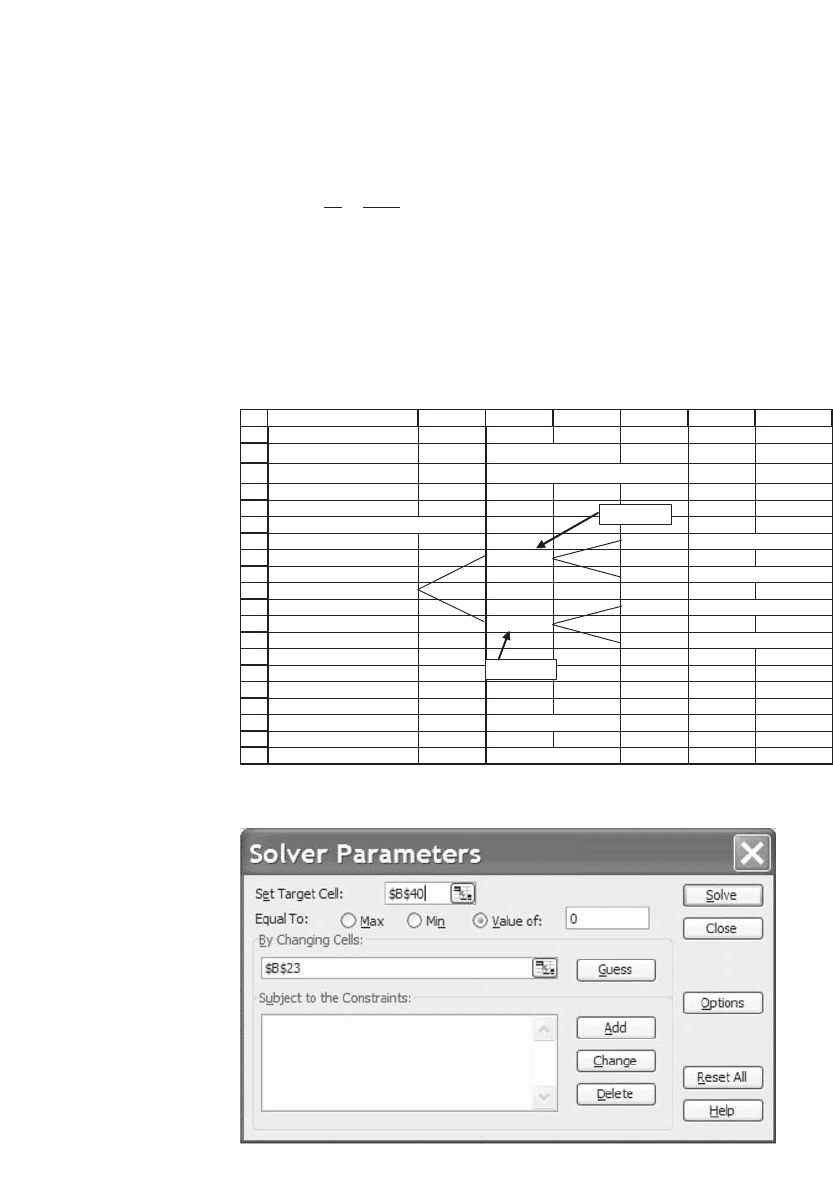
658 Chapter 24
1. They are consistent with the risk-free interest rate; therefore,
qq
R
UD
+==
11
106.
2. The state prices give the same NPV for the project as that calculated
by the cost of capital.
The second requirement means that we have to use the Excel Solver
to determine the state prices. Here’s what the solution looks like (the
discussion of how Solver was used follows this spreadsheet picture):
21
22
23
24
25
26
27
28
29
30
31
32
33
34
35
36
37
38
39
40
ABCDEF
State prices
q
U
0.4241 <-- =1/(1+B3)-B23
q
D
0.5193 <-- Determined by Solver
Project state-by-state discounting
26.9797 <-- =E6*B22^2
42.4105
17.6187 <-- =E8*B22*B23
-50
17.6187 <-- =E10*B22*B23
-25.9646
-16.1798 <-- =E12*B23^2
State-by-state NPV 12.48 <-- =SUM(A27:E33)
Target cell
G
<-- =B38-B18(0.00)
=C7*B22
=C11*B23
To determine the state prices, we use the Solver (Tools|Solver):
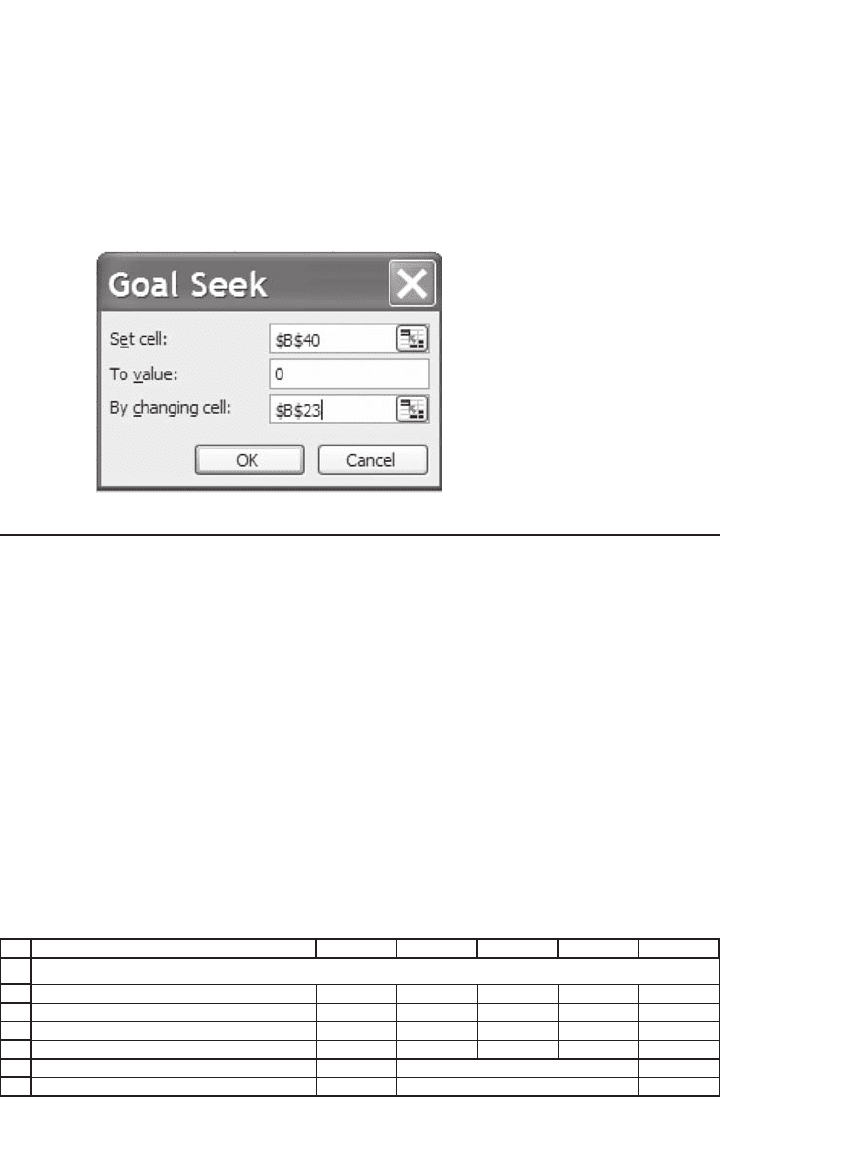
659 Real Options
You can also use Goal Seek (Tools|Goal Seek) to get the same result.
However, Excel’s Goal Seek does not remember its previous settings,
meaning that each time you repeat this calculation you will have to reset
the cell references. Here’s what the Goal Seek dialogue box looks like:
24.4 Valuing the Abandonment Option as a Series of Puts
The preceding example shows how and why the abandonment option
can have value. It also illustrates another, more troublesome, feature of
the abandonment option, namely, that it may be very diffi cult to value.
While it is diffi cult enough to project expected cash fl ows, it is even more
diffi cult to project state-by-state cash fl ows and state prices for a complex
project.
A possible compromise in the valuation of an abandonment option is
to value a project as a series of cash fl ows plus a series of Black-Scholes
put options. Consider the following example: You are valuing a four-year
project with the expected cash fl ows given in the following spreadsheet
and with a risk-adjusted discount rate of 12 percent. As you can see, the
project has a negative NPV:
1
2
3
4
5
6
7
BACDE
Pro
F
ject cash flows
Year
01234
Cash flow -750 100 200 300 400
Risk-adjusted discount rate 12% The project's cost of capital
NPV without options -33.53 <-- =B4+NPV(B6,C4:F4)
STANDARD DCF PROJECT VALUATION
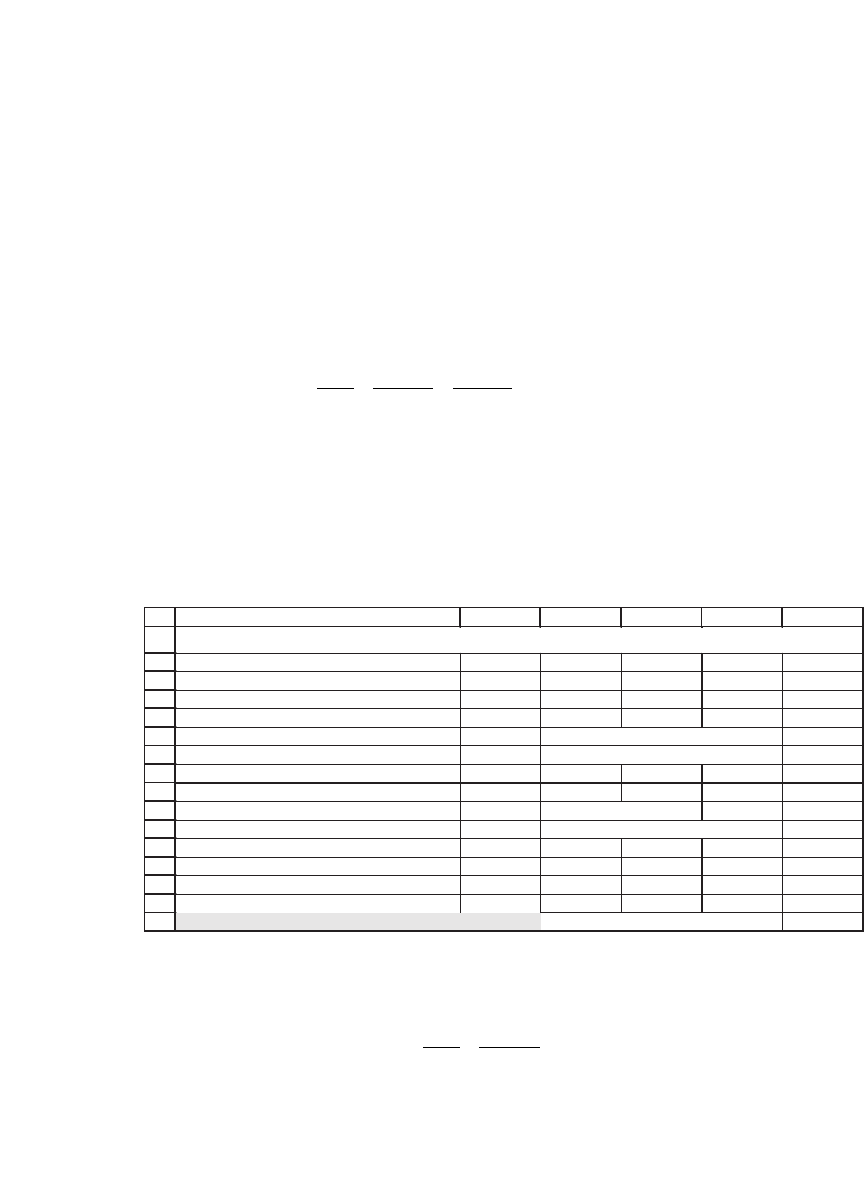
660 Chapter 24
Suppose that we can abandon the project at the end of any of the next
four years, selling the equipment for 300. Although this abandonment
option is an American option and not a Black-Scholes option, we value
it as a series of Black-Scholes put options. In each case we suppose that
we fi rst get the year-end cash fl ow; we then value the abandonment
option on the remaining project value.
•
End of year 1: The asset’s expected value at the end of year 1 will
be the discounted value of its future expected cash fl ows:
702 44
200
112
300
112
400
112
23
.
.(.)(.)
=+ +
. The abandonment option means that
we can get $300 for the asset during the next three years. Suppose that
the value has a volatility of 50 percent; then valuing this option as a
Black-Scholes put with one year to maturity gives its value as 19.53. The
following spreadsheet uses the VBA function BSPut defi ned in Chapter
19:
1
2
3
4
5
6
7
8
9
10
11
12
13
14
15
16
BACDE
F
Project cash flows
Year 01234
Cash flow -750 100 200 300 400
Risk-adjusted discount rate 12% The project's cost of capital
NPV without options -33.53 <-- =B4+NPV(B6,C4:F4)
Valuing the year-1 abandonment put
Value of project, end year 1 702.44 <-- =NPV(B6,D4:F4)
Abandonment value 300 Like strike price in put formula
Time to option maturity (years) 3
Risk-free rate 6%
Sigma 50%
Put value 19.53 <-- =bsput(B10,B11,B12,B13,B14)
ABANDONMENT VALUE--DETAILS OF YEAR-1 CALCULATION
•
End of year 2: We have a put option with exercise price $300 on an
asset worth
586 73
300
112
400
112
2
.
.(.)
=+
. Valuing the abandonment option as
a Black-Scholes put with two years to exercise gives its value (when
σ = 50 percent) as 17.74.
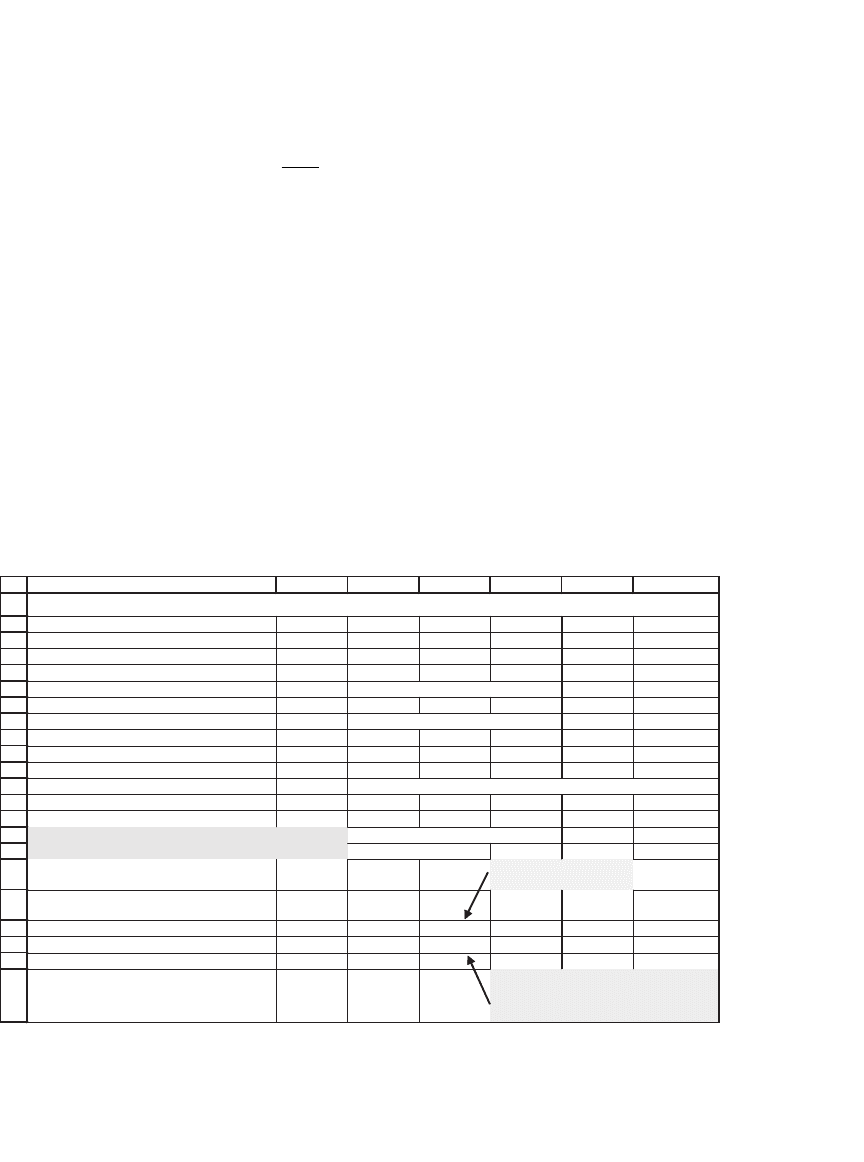
661 Real Options
•
End of year 3: We have a put option with exercise price $300 on an
asset worth
357 14
400
112
.
.
=
. The option has one more year remaining to
its life and is worth 32.47.
•
End of year 4: The asset is worthless in terms of future anticipated cash
fl ows, but it can be abandoned for $300 (this is thus its scrap or salvage
value). The abandonment option is worth $300.
In the next spreadsheet the asset has been valued as the sum of
•
The present value of the future expected cash fl ows. As we showed, this
is −$33.53.
•
The present value (at the risk-free rate) of a series of Black-Scholes
puts. This value is $299.10.
The total value of the project is −$33.53 + $299.10 = $265.57.
1
2
3
4
5
6
7
8
9
10
11
12
13
14
15
16
17
18
19
20
21
22
BACDEF
G
Project cash flows
Year 01234
Cash flow -750 100 200 300 400
Risk-adjusted discount rate 12% The project's cost of capital
NPV without options -33.53 <-- =NPV(B6,C4:F4)+B4
Sigma 50%
Risk-free rate 6%
Abandonment value 300 Project can be abandoned at end of any year for this amount
NPV of cash flows at RADR -33.53 <-- =B8
Value of abandonment option 299.10 <-- =NPV(B11,C20:F20)
Adjusted present value 265.57 <-- =B15+B14
End-year value of remaining cash flows 702.44 586.73 357.14 0.00
Put option value 19.53 17.74 32.47 300.00
Function in cell D19:
=NPV($B$6,E4:$F$4)
Function in cell D20:
=bsput(D19,$B$12,$F$3-
D3,$B$11,$B$10)
PRICING AN ABANDONMENT OPTION AS A SERIES OF PUTS

662 Chapter 24
24.5 Valuing a Biotechnology Project
4
One of the interesting features of the biotech industry is the existence
of highly valued fi rms that have no revenues. It is common understanding
that the value of those fi rms is in their future cash fl ow opportunities.
Therefore, understanding the translation of qualitative investment
opportunities into quantitative valuation is of great importance when
valuating those fi rms. In this section we use the real-option method to
value a biotechnology project and to illustrate the application of the
real-option approaches.
Consider the following story.
5
A fi rm is considering the initiation of
research into a new drug. It knows that there are three stages to the
drug’s development:
1. In the discovery phase the fi rm does preliminary research about the
viability of the idea. This research takes one year and costs $1,000 at
the beginning of the year, with 50 percent probability that the results
will be positive enough to proceed to the next stage of research.
2. If the discovery phase yields success, then the drug goes into the clini-
cal phase, in which the drug is tested. This stage lasts one year, costs
$2,000 at the beginning of the year, and with a probability of 30 percent
yields enough positive results to proceed to the next stage.
3. If the drug passes the clinical phase successfully, then it goes into the
market stage, in which it is sold. This phase costs $15,000 per year (at the
beginning of each year) and on average lasts fi ve years. On average, a
successful drug can be expected to start the marketing phase with income
of $20,000. This income grows with annual mean 10 percent and standard
deviation σ = 100 percent.
The expected return on a project of this type is 25 percent. We assume
that this is the cost of capital of the project in the case of a discounted-
cash-fl ow (DCF) valuation.
4. A version of this example originally appeared in Benninga and Tolkowsky (2002).
5. We have made the story simple enough to fi t an understandable spreadsheet. For a
somewhat more complicated story in the same spirit, see Kellogg and Charnes
(2000).
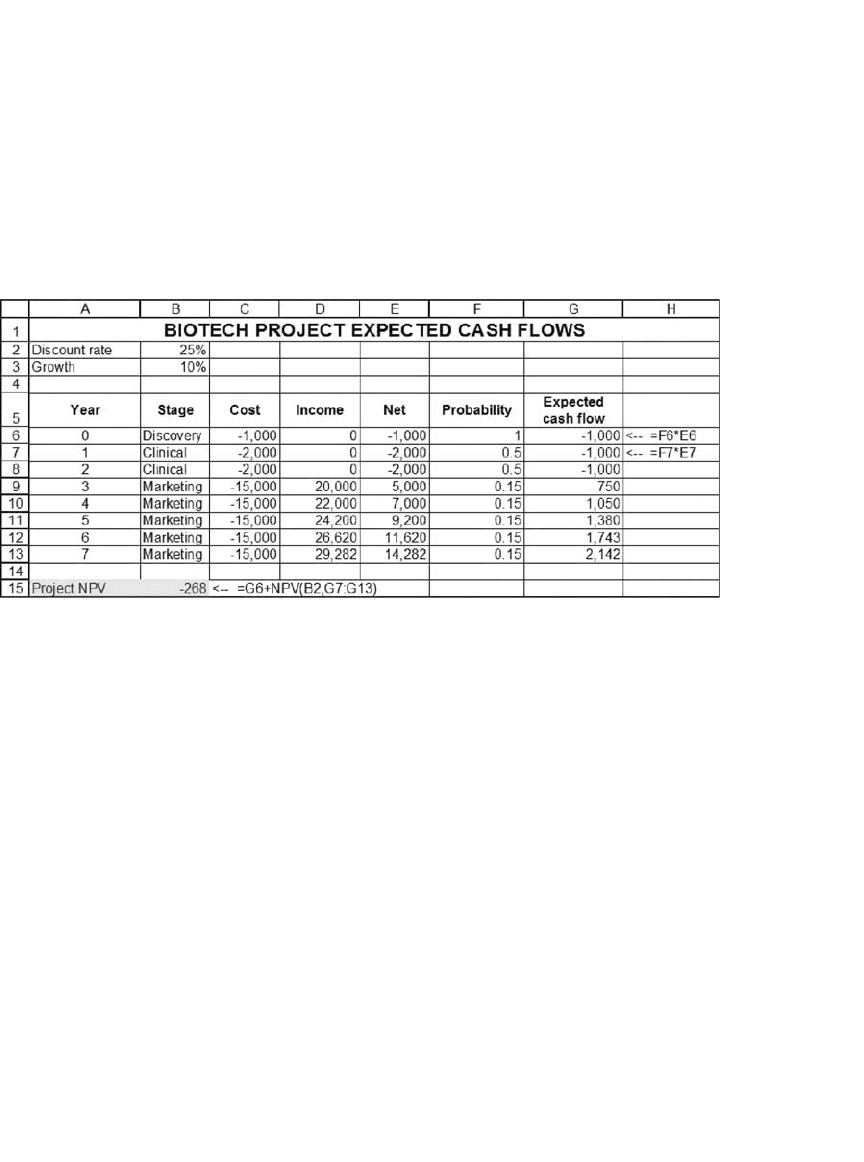
663 Real Options
24.5.1 The Expected Value of the Project Using Traditional Discounted-
Cash-Flow Analysis
If we estimate the value of this project using traditional discounted-cash-
fl ow analysis, we get a negative net present value for the project:
Since the project’s net present value is negative, the DCF approach
indicates that it should not be undertaken.
24.5.2 Using a Real-Options Approach
An alternative method for estimating the present value of proceeds is
to plot the project’s cash fl ows on a binomial tree. This is done in the
following spreadsheet:
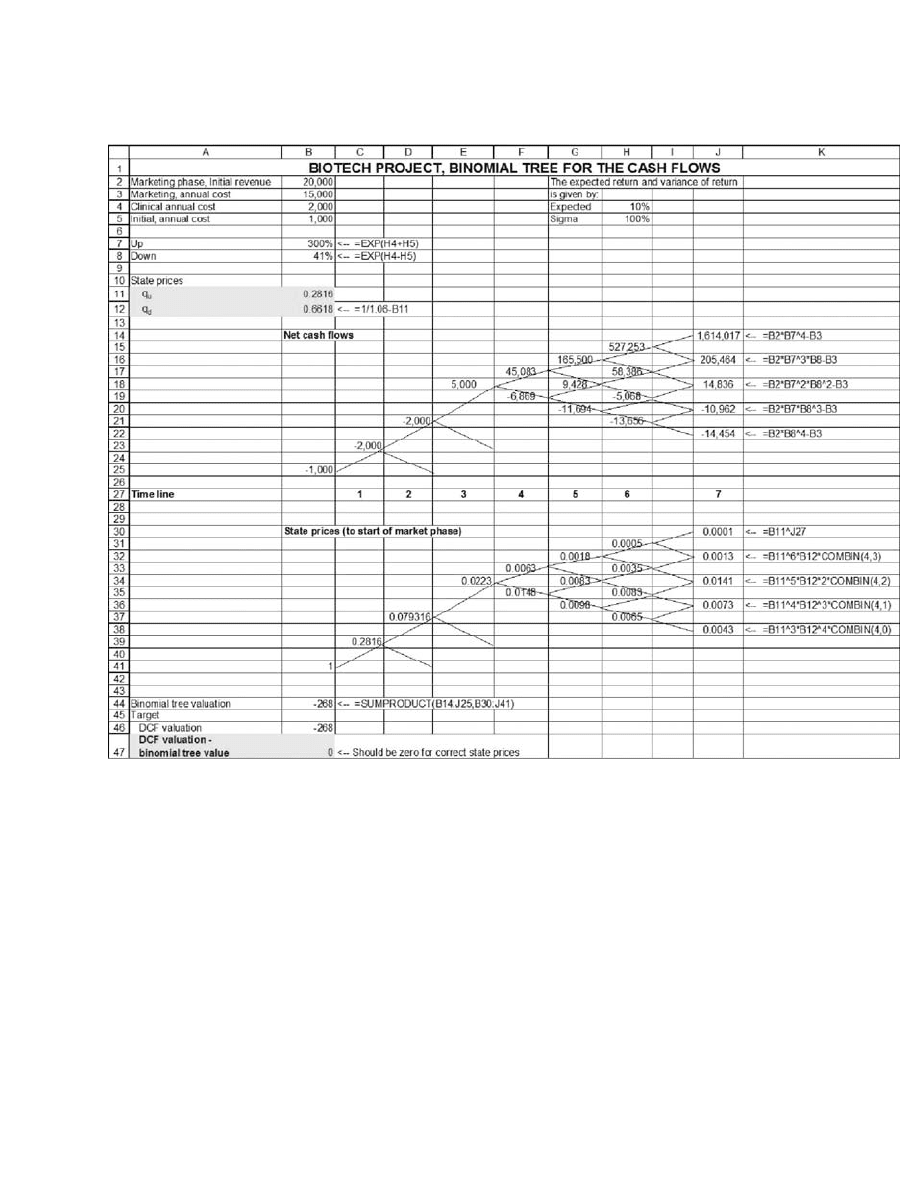
664 Chapter 24
We use the Excel function Sumproduct to do this computation.
24.5.3 A Note about the State Prices
The net present value of the proceeds from this project is the product
of the net cash fl ows and the appropriate state prices:
NPV CF q q
jt
j
t
t
U
j
D
tj
=∗∗∗
⎛
⎝
⎜
⎞
⎠
⎟
==
−
∑∑
00
7
()()
Number of
paths to node
,,
where CF
jt
denotes the proceeds from the project at date t and state j,
and where j is the number of up moves. As explained in Chapter 17, in the
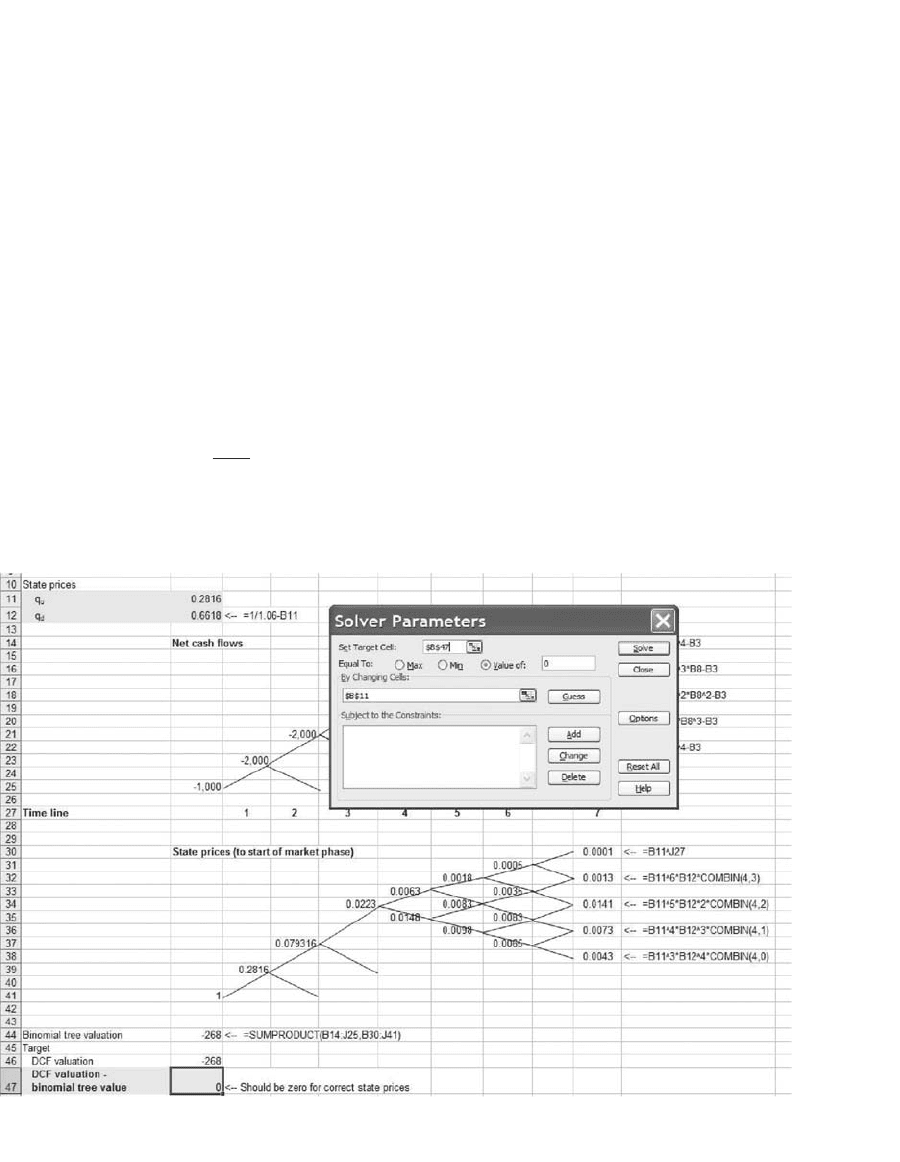
665 Real Options
standard binomial model, the state price for a node is
()() ,qq
t
j
U
j
D
nj
∗
⎛
⎝
⎜
⎞
⎠
⎟
−
where n is the time at which the node occurs, j is the number of Up steps
needed to get to the node, and
t
j
⎛
⎝
⎜
⎞
⎠
⎟
is the number of paths to reach the
node. The latter expression is computed in Excel by using the function
Combin(n,j). However, for the preceding real-options model, the number
of paths to each node is slightly different, since the beginning of the tree
(the initial and clinical states) are accessible via only one path.
In the preceding spreadsheet, the prices q
U
and q
D
were computed
(using Solver) so that the present value of the project on the binomial tree
equals that of the DCF valuation and that the equilibrium condition,
qq
UD
+=
1
106.
holds. Here’s the Solver screen:
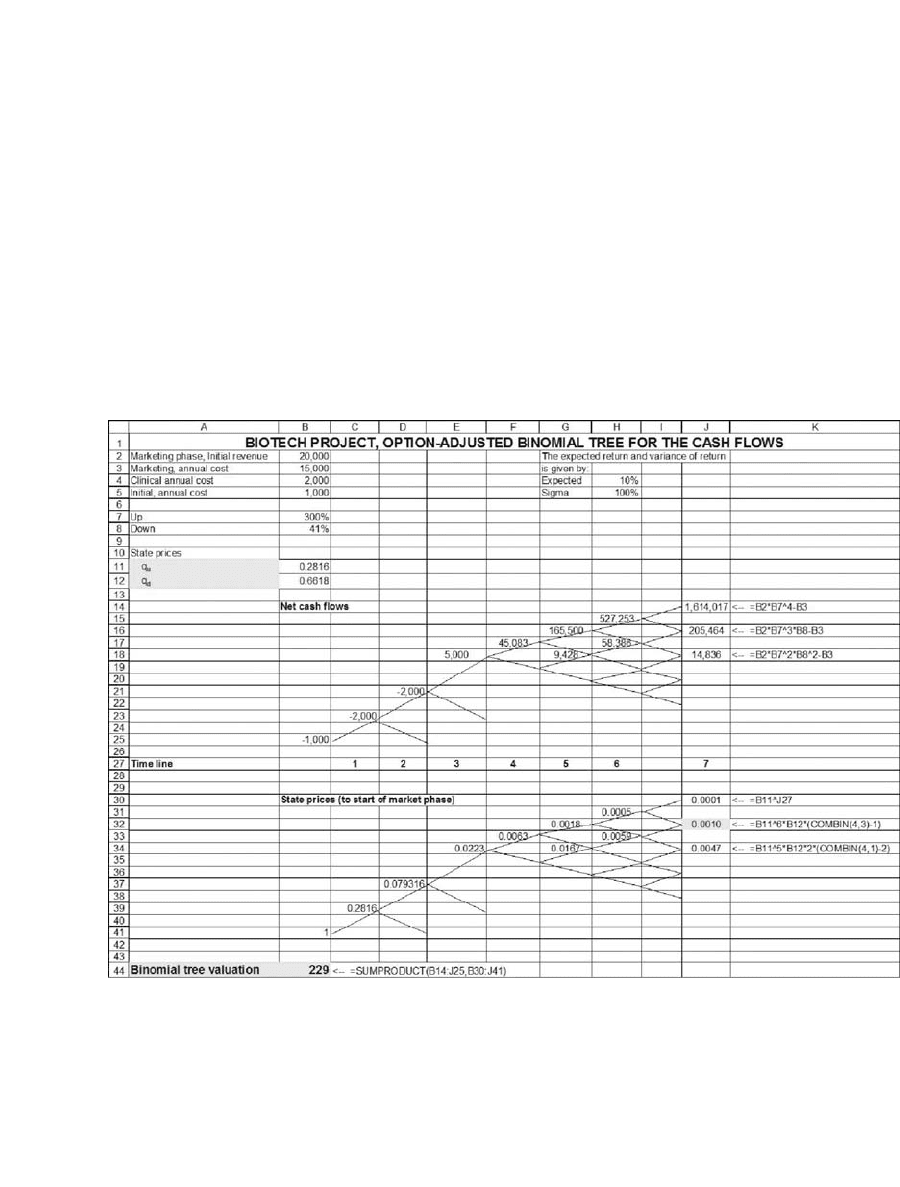
666 Chapter 24
24.5.4 The Real-Options Approach
The real-options approach to R&D recognizes that at each stage in the
project the managers can choose whether to continue the project or not.
They do this by comparing the value and costs of continuation. In option
terminology, at each stage, the manager exercises her continuation option
if the value from exercising the option exceeds the exercise price. In the
following spreadsheet, we have eliminated obvious negative cash fl ows
from the marketing stage, taking care to also eliminate the subsequent
cash fl ows and to make an adjustment to the state prices:
24.5.5 Another Note about State Prices
When we eliminate states in the real-option approach, we must also
adjust the number of paths to each node to account for the fact that some
states are no longer reachable. This has been done in the preceding
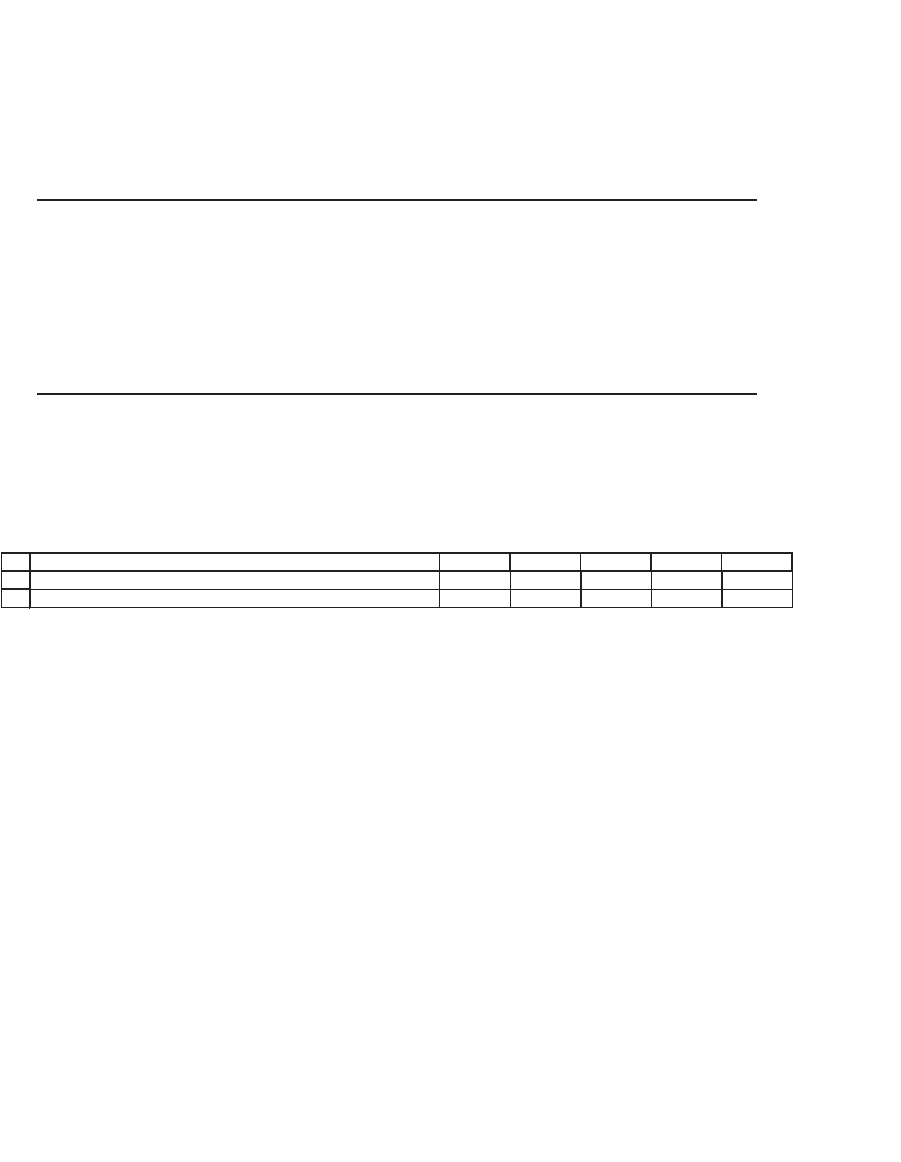
667 Real Options
spreadsheet. For example, the state in cell J7 (highlighted) is now reach-
able by one fewer path.
24.6 Conclusion
Recognizing that capital budgeting should include option aspects of
projects is clear and obvious. Valuing these options is often diffi cult. In
this chapter we have tried to emphasize the intuitions and—insofar as is
possible—to give some implementation of the valuation.
Exercises
1. Your company is considering purchasing 10 machines, each of which has the follow-
ing expected cash fl ows (the entry in B4 of −$550 is the cost of the machine):
You estimate the appropriate discount rate for the machines as 25 percent.
a. Would you recommend buying just one machine, if there are no options
effects?
b. Your purchase manager recommends buying one machine today and then—after
seeing how the machine operates—reconsidering the purchase of the other nine
machines in six months. Assuming that the cash fl ows from the machines have a
standard deviation of 30 percent and that the risk-free rate is 10 percent, value
this strategy.
2. Your company is considering the purchase of a new piece of equipment. The equip-
ment costs $50,000, and your analysis indicates that the PV of the future cash fl ows
from the equipment is $45,000. Thus the NPV of the equipment is −$5,000. This
estimated NPV is based on some initial numbers provided by the manufacturer plus
some creative thinking on the part of your fi nancial analyst.
The seller of the new piece of equipment is offering a course on how it works.
The course costs $1,500. You estimate that
•
The σ of the equipment’s cash fl ows is 30 percent.
•
The risk-free rate is 6 percent.
•
You will have another half year after the course to purchase the equipment at
the price of $50,000.
Is it worth taking the course?
3
4
FEDCBA
43210raeY
CF of sing 004003002001055-enihcamel
